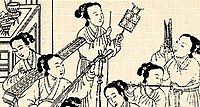Chinese musicology

Chinese musicology is a way of studying and understanding music from China. It's like exploring a treasure chest full of music from a different world and time.
There are different types of Chinese music, such as classical and folk music. Just like how a book has chapters, Chinese classical music has different "modes" or "scales" that help give the music a certain feel or mood. Think of it like different colors of paint that you can use to make a picture. The musicians use these modes to create beautiful and complex melodies that are different from what you might hear in Western music.
In Chinese folk music, there are often instruments like the erhu (a type of violin) and the guzheng (a stringed instrument). These instruments have a unique sound that is very different from what you might hear on a guitar or piano. The musicians also use different techniques, such as sliding their fingers up and down the strings or using a bow that has a special grip, to create even more unique sounds.
Chinese musicology is also about understanding the history and culture behind the music. Chinese music has been around for thousands of years and has been influenced by different dynasties and regions. Some types of music were played at important ceremonies or festivals, while others were meant to soothe and heal. By studying Chinese musicology, we can learn more about the people and traditions that created it.
In conclusion, Chinese musicology is like exploring a magical world full of beautiful sounds, interesting instruments, and rich history. It's a way to appreciate and understand the music of a different culture, and to gain a deeper appreciation for the beauty and complexity of music in general.
There are different types of Chinese music, such as classical and folk music. Just like how a book has chapters, Chinese classical music has different "modes" or "scales" that help give the music a certain feel or mood. Think of it like different colors of paint that you can use to make a picture. The musicians use these modes to create beautiful and complex melodies that are different from what you might hear in Western music.
In Chinese folk music, there are often instruments like the erhu (a type of violin) and the guzheng (a stringed instrument). These instruments have a unique sound that is very different from what you might hear on a guitar or piano. The musicians also use different techniques, such as sliding their fingers up and down the strings or using a bow that has a special grip, to create even more unique sounds.
Chinese musicology is also about understanding the history and culture behind the music. Chinese music has been around for thousands of years and has been influenced by different dynasties and regions. Some types of music were played at important ceremonies or festivals, while others were meant to soothe and heal. By studying Chinese musicology, we can learn more about the people and traditions that created it.
In conclusion, Chinese musicology is like exploring a magical world full of beautiful sounds, interesting instruments, and rich history. It's a way to appreciate and understand the music of a different culture, and to gain a deeper appreciation for the beauty and complexity of music in general.
